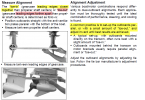I took possession of a new 30 foot QX with twin Merc 450R outboards earlier this year. Each pontoon has a wedge shaped welded bracket that the outboards mount to which makes each one point a few degrees out making them splayed out slightly instead of straight back in relation to the boat. There isn't a tie bar between the motors because it is equipped with the joystick option. Can anyone explain why they are mounted this way? I would have thought that it would be more efficient to have them mounted pointing straight back from the pontoons. Thanks
Navigation
Install the app
How to install the app on iOS
Follow along with the video below to see how to install our site as a web app on your home screen.
Note: This feature may not be available in some browsers.
More options
You are using an out of date browser. It may not display this or other websites correctly.
You should upgrade or use an alternative browser.
You should upgrade or use an alternative browser.
mounting question for twin outboards
- Thread starter Blackgold
- Start date
SEMPERFI8387
Moderator
Maybe offset prop torque or are they dual props?
They are single props with one spinning clockwise and the other counter clockwise. I would think that would cancel any prop torque. I never checked the position of the engines at cruising speeds but maybe they do point straight back. With the joystick there isn't a tie bar between the two outboards to keep them aligned. Maybe the control unit that positions the outboards keeps them straight back.
FIRE UP
Well-Known Member
- Messages
- 192
- Reaction score
- 363
Well Black Gold,
First, I envy the heck out of you. We have a 26' R with the Yamaha 350HP and love that tri-toon to death. But, while I'm not any form of high speed freak, I do love the idea of twin engines on these large floating battleships. Since no one yet has jumped in with some form of a technical answer as to why each engine is cantored slightly opposite in their mount system, my suggestion would be to contact the engineering department of Bennington and speak with one of the boys that has the drafting table in front of them. Now, unless someone on this forum has done that, (called the factory), and can give you the EXACT reason for the design, we can all sort of surmise as to the reasoning for the design.
Yes, mounted completely straight forward, with zero side angle, sure seems that it would be the most efficient operational design. But, I just ride and play on them, not design them. It will be interesting to hear/read the actual correct answer for your question. One guess I might have is, since boats don't have wheels on the ground, like a car does on the road, which, keeps a car going dead straight, at the slowest speeds, boats, have a slight tendency to *wander* a bit. They will slightly move from center and a slight amount of *correction* must be applied to keep them heading straight ahead. Now, again, I'm no designer but, that's the way it's been for the 6 boats we've had, in various hull designs engines, over a 35+ year period. Maybe yours, with that design, allows for dead-on straight idling at very slow speeds.
Scott
First, I envy the heck out of you. We have a 26' R with the Yamaha 350HP and love that tri-toon to death. But, while I'm not any form of high speed freak, I do love the idea of twin engines on these large floating battleships. Since no one yet has jumped in with some form of a technical answer as to why each engine is cantored slightly opposite in their mount system, my suggestion would be to contact the engineering department of Bennington and speak with one of the boys that has the drafting table in front of them. Now, unless someone on this forum has done that, (called the factory), and can give you the EXACT reason for the design, we can all sort of surmise as to the reasoning for the design.
Yes, mounted completely straight forward, with zero side angle, sure seems that it would be the most efficient operational design. But, I just ride and play on them, not design them. It will be interesting to hear/read the actual correct answer for your question. One guess I might have is, since boats don't have wheels on the ground, like a car does on the road, which, keeps a car going dead straight, at the slowest speeds, boats, have a slight tendency to *wander* a bit. They will slightly move from center and a slight amount of *correction* must be applied to keep them heading straight ahead. Now, again, I'm no designer but, that's the way it's been for the 6 boats we've had, in various hull designs engines, over a 35+ year period. Maybe yours, with that design, allows for dead-on straight idling at very slow speeds.
Scott
Last edited:
Potomacbassin’
Well-Known Member
Watching the motors move from side to side, facing each other or away from each other and going from forward to reverse when operating the joy stick is amazing. My guess is they need a little more angle out then in when working with the joy stick. Might try to find the install manual for the joy stick system.


